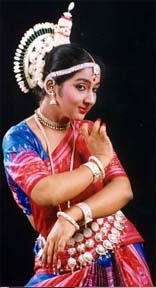Apr 19, 2024
Apr 19, 2024
 Dance is the earliest language of the human race. In the primitive ages, when there were no languages, ancient man used gestures to communicate. Even after the languages came into existence man still used gestures along with language to express himself effectively. Dance is nothing but the expression of the mind through body movements. Dance in Indian culture is believed to be a manifestation of Divinity. According to the Natya Shastra, Brahma the Supreme Creator took the recitation from the Rig Veda, the song from the Sama Veda, the Abhinayas from the Yajur Veda and created the fifth Veda the Natya Veda.
Dance is the earliest language of the human race. In the primitive ages, when there were no languages, ancient man used gestures to communicate. Even after the languages came into existence man still used gestures along with language to express himself effectively. Dance is nothing but the expression of the mind through body movements. Dance in Indian culture is believed to be a manifestation of Divinity. According to the Natya Shastra, Brahma the Supreme Creator took the recitation from the Rig Veda, the song from the Sama Veda, the Abhinayas from the Yajur Veda and created the fifth Veda the Natya Veda.
The Hindu Pantheon is replete with Gods and Goddesses using the medium of dance to express their feelings and emotions. Done the gages Dance has always symbolized the best and the noblest aspect of India's rich and glorious cultural heritage.
Odissi dance is considered one of the oldest based on archeological evidence. The present day Odissi is however a culmination of a process of reconstruction from various dance traditions of Orissa like the Maharis, the Goptuas and the Bhandanrutya traditions. Maharis are equivalent to the Devadasis of the South. Goptuas are basically men who dressed themselves like female dancers and danced like the Maharis. Jayadeva's Gitagovinda has enriched the content and style of this form of dance.
A typical Odissi dance begins with Mangalacharan. Here the danseuse prays to Mother Earth seeking her forgiveness for stepping on her, as was well as her blessings. Next the danseuse pays obeisance to the Lord and then seeks the blessings of the audience. Finally she invokes her Guru.
The next stage is the Batu nrutya where the danseuse pays a tribute to Natraja, the Lord of Dance.
Pallavi, which means a new leaf, follows. It is the most graceful part of Odissi with soft, rhythmic movements set to various ragas.
If Pallavi epitomizes grace than Abhinaya symbolizes eloquence of expressions. The love stories of Radha and Krishna, Shiva and Parvati are enacted with facial expressions and gestures serving as the media of communication.
Moksha is the culmination, with the danseuse depicting the search for Nirvana.
Odissi is not merely a dance form. It is a synthesis of beauty, grace, rhythm, melody, spirituality and devotion. It provides a feast for the eyes, music for the ears and succor for the soul. Through this dance, the danseuse pays obeisance to the Lord in all his myriad manifestations. In essence this unique dance form is a tribute to divinity.
09-Mar-2001
More by : Ramendra Kumar